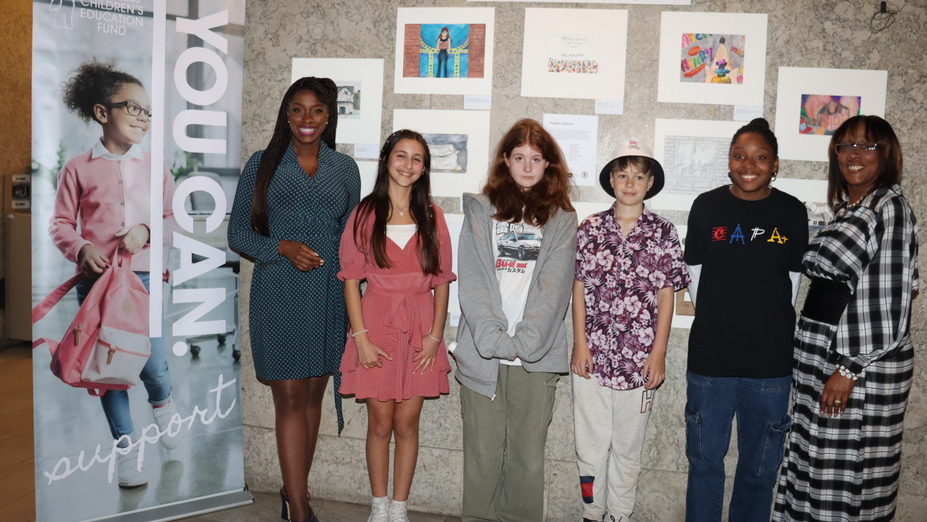A.J. JEFFERSON, CEO OF THE HOMELESS CHILDREN’S EDUCATION FUND, FAR LEFT, AND PITTSBURGH FIRST LADY MICHELLE GAINEY, FAR RIGHT, WITH STUDENTS WHO HELPED MAKE AN ART EXHIBIT AT THE CITY-COUNTY BUILDING, DOWNTOWN. (PHOTO BY J.L. MARTELLO)
More than 3,000 youth are classified as homeless in Allegheny County
Head into the City-County Building, Downtown, and you’ll see it—an art exhibition done by middle school students at Pittsburgh CAPA that shows a child’s view of housing insecurity.
And housing insecurity, or instability, or more bluntly, homelessness, is a real thing in the Pittsburgh area for young people. More than 3,000 of them, children and youth, are known to be experiencing homelessness, though the actual number is probably higher. If a child is not living in their own home, such as living with a friend or a relative, or going from house to house, that classifies as homelessness.
While there is a renewed focus on homelessness among adults in Downtown and other parts of Pittsburgh of late, people like Pittsburgh’s First Lady, Michelle Gainey, and Homeless Children’s Education Fund CEO A.J. Jefferson won’t let you forget about the kids who are homeless.

PITTSBURGH FIRST LADY MICHELLE GAINEY SPEAKS AT THE CITY-COUNTY BUILDING. (PHOTO BY J.L. MARTELLO)
The art exhibition will continue to be displayed at the City-County Building through mid-December. It was unveiled in October. The “Hidden Stories” exhibition includes 22 two-dimensional pieces created in various media —watercolor, colored pencil, paint and acrylic—all meant to demonstrate diversity, educate audiences and evoke emotion, HCEF said.
“Each month, The Greater Pittsburgh Art Project features a unique theme dedicated to uplifting Pittsburgh’s diverse voices,” said Michelle Gainey, in a statement provided to the New Pittsburgh Courier. “Since HCEF celebrates Homeless Children’s Awareness Month every October, we used this opportunity to partner with Pittsburgh CAPA, allowing its students to learn about different cultures and express their thoughts through art on youth homelessness and housing insecurity, an unfortunate crisis in our city.”

Whether it’s the “Sunday Business Page” with Jon Delano on KDKA-TV, “The Rick Dayton Show” on KDKA Radio, at press conferences, with KiKi Brown on WAMO Radio, or at the grocery store, Jefferson is everywhere making sure people understand the severity of the issue of youth homelessness. She also tells people that they can help by volunteering their time with HCEF, or contributing financially to the non-profit, to help keep the educational programs that HCEF provides going.

A.J. JEFFERSON, CEO OF HCEF
Of the many programs HCEF provides, one is its “Teen Outreach Program,” which gives the teens the opportunity to be put in peer support networks, a college and career readiness program, and a chance to learn leadership and entrepreneurial skills, as well as health and wellness, and civic engagement.
Another program HCEF has is its “School Supplies and Backpacks” initiative, which strives to give as many children experiencing homelessness a stuffed backpack just in time for school.
“As the mayor (Ed Gainey) said, five dollars is a great gift, especially when 2,000 people are giving it,” Jefferson told Delano on KDKA-TV earlier this year.

In a press release from HCEF to the Courier, HCEF said that “since young people who experience homelessness are much less likely to graduate from high school (only 64 percent graduate compared to 84 percent of the total population), there is a direct pipeline from youth homelessness to adult homelessness.” The release also said that someone who does not graduate high school “is 346 percent more likely to experience homelessness as a young adult.”
“We end the cycle of homelessness,” Jefferson said on KDKA-TV. “We believe that the number one prevention to do that is education. We offer a multitude of programs and supportive services that focuses our students in achieving education and closing that educational gap or divide they experience every time they have to move to a different residence or shelter or dwelling.”
Jefferson said that when a child has to move, oftentimes “they don’t feel secure, they don’t feel like they can achieve academically, and they lose the desire to want to achieve or go to school.”
That’s why HCEF works with schools, parents, and the kids to try to “provide those students a measure of stability in hopes they can walk with us through the education process.”


